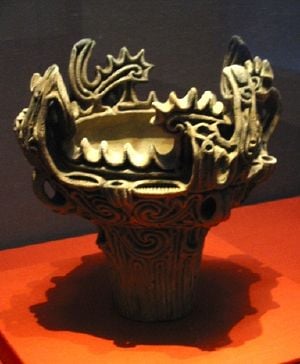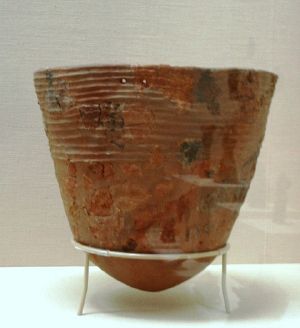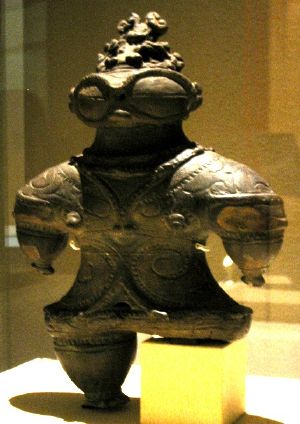
The Jomon period (縄文時代, Jōmon-jidai) is the period of Japanese prehistory from about 10,000 B.C.E. to 300 B.C.E., during which the earliest major culture of prehistoric Japan developed and flourished. The word “jomon” (cord-pattern) refers to the characteristic ornamentation of clay vessels and figures with impressions or markings made using sticks with cords wrapped around them. Numerous archaeological sites with artifacts of this Neolithic culture have been discovered, from the northern island of Hokkaido to the southern Ryukyus, but they appear most commonly in eastern Japan where the culture survived longest.
The Early and Middle Jomon periods correspond to a period of climactic warming (the prehistoric holocene climatic optimum between 4000 and 2000 B.C.E.), when the population expanded rapidly. The Jomon people lived in small communities of sunken pit dwellings and subsisted mainly by hunting, fishing, and gathering. Archaeological evidence indicates that they were semi-sedentary and that they carried on trade among themselves and possibly with the Korean peninsula. The Jomon people produced some of the earliest known pottery vessels in the world, dated to the eleventh millennium B.C.E., making vessels of unrefined, low-fired clay, baked in open fires. Later Jomon pottery, which included figurines probably intended as fertility symbols, showed increasingly sophisticated style and function and refined ornamentation. By the end of the Jomon period, incipient cultivation had evolved into sophisticated rice-paddy farming and government control. There is evidence that many other elements of Japanese culture including Shinto mythology; marriage customs; ceremonies; architectural styles; and technological developments such as lacquerware, textiles, laminated bows, metalworking, and glass making, may also date from this period.
Six sub-periods
The Jomon period is divided into six sub-periods, but scholars disagree about the exact dates for each period. The sub-periods are:
- Incipient Jomon 13000-8000 B.C.E. or 11000-7500 B.C.E.
- Earliest (Initial) Jomon 8000-5000 B.C.E. or 7500–4000 B.C.E.
- Early Jomon 5000-2500 B.C.E. or 4000–3000 B.C.E.
- Middle Jomon 2500-1500 B.C.E. or 3000–2000 B.C.E.
- Late Jomon 1500-1000 B.C.E. or 2000–1000 B.C.E.
- Final (Latest) Jomon 1000-300 B.C.E. or 1000–500 B.C.E.
Pre-Jomon
Most scholars agree that by around 40,000 B.C.E., glaciation had connected the Japanese islands with the Asian mainland. Based on archaeological evidence, between 35,000 B.C.E. and 30,000 B.C.E., Homo sapiens had migrated to the islands from eastern and southeastern Asia and had well-established patterns of hunting and gathering and stone toolmaking. Stone tools, inhabitation sites, and human fossils from this period have been found throughout all the islands of Japan. Additionally, a 1988 genetic study points to an East Asian base, probably in Siberia, as the origin for the Japanese people.[1]
Incipient and initial Jomon (10,000–4,000 B.C.E.)
More stable living patterns had arisen by around 10,000 B.C.E., in a culture that some scholars characterize as Mesolithic and others as Neolithic, but which had some characteristics of both. Possibly distant ancestors of the Ainu aboriginal people of modern Japan, members of the heterogeneous Jomon culture (c. 10,000-300 B.C.E.) left the clearest archaeological record. The culture was roughly contemporaneous with civilizations in Mesopotamia, the Nile, and the Indus Valley.
The Incipient Jomon period was a time of transition from Paleolithic to Neolithic ways of life. The origins of Jomon culture are uncertain, although similarities with early cultures of northeast Asia and America have been detected. Archaeological evidence shows that the people were hunter-gatherers living in simple surface dwellings. They produced pottery cooking containers with pointed bottoms, decorated with cord markings, among the oldest known examples of pottery.
By the Initial Jomon period, the gradual climactic warming which had begun around 10,000 B.C.E. had raised sea levels so that the southern islands of Shikoku and Kyushu were separated from the main island of Honshu. Warmer temperatures meant an increase in the food supply, which, according to evidence found in ancient shell mounds, was derived from the sea as well as from hunting game and gathering plants, fruits, and seeds. Stone tools such as grinding rocks, knives, and axes were used.
Early Jomon (5000-2500 B.C.E. or 4000–3000 B.C.E.)
The Early and Middle Jomon periods saw an explosion in population, as indicated by the number of excavations from this period. These two periods correspond to the prehistoric holocene climatic optimum (between 4000 and 2000 B.C.E.), when temperatures reached several degrees Celsius higher than the present, and the seas were higher by 5 to 6 meters.[2] Beautiful artistic realizations, such as highly decorated "flamed" vessels, remain from that time.
Huge shell mounds indicate that the people of this period continued to derive a large portion of their daily food supply from the ocean. The pottery produced in Kyushu exhibits similarities to pottery of that time period found in Korea, suggesting that regular communication existed between the Japanese islands and the Korean peninsula. The people of the early Jomon period lived in square pit houses, clustered in small villages, and produced a variety of items such as cord-marked earthenware cooking and storage vessels, woven baskets, bone needles, and stone tools.
Middle Jomon (2500-1500 B.C.E. or 3000–2000 B.C.E.)
The Middle Jomon period marked the high point of the Jomon culture in population growth and the production of handicrafts. Climactic warming peaked, causing the movement of communities into mountainous areas. Larger refuse heaps are evidence that people had become more sedentary and lived in larger communities. They fished, hunted game such as deer, bear, rabbit, and duck, and gathered nuts, berries, mushrooms, and parsley. There may have been early attempts at plant cultivation. A practice of burying the deceased in shell mounds, and a larger number of stone female figurines and phallic images of stone dating to this period are evidence of an increase in ritual practices.
Late Jomon (1500-1000 B.C.E. or 2000–1000 B.C.E.)
After 1500 B.C.E., populations seem to have contracted dramatically, probably due to climactic changes. Comparatively few archaeological sites can be found after 1500 B.C.E.
Cooling climates attracted the population to settle closer to the coast, especially along the eastern shores of Honshu. Innovations in fishing technology, such as development of the toggle harpoon and deep-sea fishing techniques, appear to have increased the communication among communities, as indicated by a greater similarity among the artifacts found in different areas. Circular ceremonial sites assembled from stones, in some cases from thousands of stones, are evidence that the enactment of rituals had become more important.
Final (Latest) Jomon (1000-300 B.C.E. or 1000–500 B.C.E.)
Population declined dramatically as the climate cooled and food became scarce. Groups became isolated from each other and regional differences became more pronounced. It is believed that domesticated rice was introduced to Japan at this time.
Early pottery

Archaeological evidence suggests that the Jomon people may have created the first known pottery vessels in the world, dated to the eleventh millennium B.C.E. Jomon pottery was made of unrefined, low-fired clay, using manual methods such as rolling the clay into a rope and coiling it upwards from a base. Vessels were heaped up and baked in open fires. Early pottery was mostly in the form of jars and bowls, but later Jomon pottery, which included figurines probably intended as fertility symbols, showed increasing variety of style and function and refinements in technical and decorative skills. Jomon clay figures and vessels were decorated with increasingly sophisticated patterns made by impressing the wet clay with braided or unbraided cord and sticks.[3] Wooden bowls and bone tools have also been found in Jomon sites, as well as the earliest ground stone tools.
The antiquity of Jomon pottery was first verified after the World War II|Second World War, through radiocarbon dating methods.[4] However, some Japanese scholars believe that pottery production technology was first invented on the mainland, because sites in what are now China and Russia have produced pottery "which may be as old, if not older, than Fukui Cave pottery."[5]
Neolithic traits
The manufacture of pottery typically implies some form of sedentary life, since pottery is highly breakable and is therefore useless to hunter-gatherers who are constantly on the move. Therefore, the Jomon were probably some of the earliest sedentary, or at least semi-sedentary, people in the world. They used chipped stone tools, ground stone tools, traps, and bows, and were probably semi-sedentary hunters-gatherers and skillful coastal and deep-water fishermen. They practiced a rudimentary form of agriculture and lived in caves, and later in groups of either temporary shallow pit dwellings or above-ground houses, leaving rich kitchen middens for modern anthropological study. Because of this, the earliest forms of farming are sometimes attributed to Japan (Ingpen & Wilkinson) in 10,000 B.C.E., two thousand years before their widespread appearance in the Middle East. However, some archaeological evidence also suggests early experiments with agriculture in the hills and valleys of the Fertile Crescent in modern Syria, Jordan, Turkey, and Iraq around 11,000 B.C.E.[6]
“Tree Culture" and pit dwellings
Jomon culture is also referred to as “Tree Culture," because trees were utilized in building construction, and in the manufacture of ceremonial ornaments and daily implements. As food surpluses increased, small villages gradually became large, apparently trading among themselves and holding ceremonies.
The advent of earthenware caused a change of diet, indicated by the remains of burned, smoked, dried, and boiled foods. The Jomon people began to travel less for hunting, and developed more permanent settlements, precursors of small villages, consisting of four or five related households located near a spring or river, or possibly on a hill. The Jomon people dug a pit into the ground and formed a floor several feet below the surface. The shape and size of the houses varied according to the time period and the region. The base of each house was usually ten to twenty feet long and elliptical in shape, with a hearth set in the center for a fire. The Jomon used chestnut trees for the framework of these pit dwellings.
The Jomon culture also crafted wooden items such as canoes, bows, buckets, combs, bangles, and ignition tools, which were sometimes lacquered. Their woodcrafts demonstrated a thorough familiarity with the qualities of each kind of wood; chestnut was used for building houses because it was hard and durable. Recent evidence shows that the Jomon also constructed massive wooden platforms, which would have required the cooperation of a large workforce, probably controlled by a highly organized society.
Jomon shell mounds and cookies
In the early Jomon periods, seasonal foods were procured mainly by hunting, gathering, and fishing. The Jomon ate birds, reptiles, amphibians, fish, and other animals that were in close proximity to their villages, and gathered nuts, mushrooms, edible wild plants, mollusks, and shellfish. Mollusks were harvested in the spring, and the Jomon people left many shell mounds throughout their territory. Chestnut trees were managed for their timber and for their nuts, which were gathered in the fall and provided a stable food supply. The Jomon cooked and preserved foods, and stored food and nuts in holes for use throughout the year. Villages along the coast traded seafood and salt for foods and resources from the mountain villages. All of these activities inspired the development of techniques for processing and preserving foods.
A popular Jomon food was a cookie made from seasonal ingredients, such as powdered nuts, chopped meat, egg, salt, and water. The "Jomon Cookie" was high in nutrition, so that several cookies could supply daily nutritional needs.
Tooth-pulling and ceremonies
The Jomon people held a variety of regional ceremonies. Teeth were pulled in a coming-of-age ritual when children reached the age of fourteen to sixteen years old. Large chestnut trees were cut and dragged down the hillsides into the villages. Residents of neighboring villages attended these ceremonies and danced, sometimes wearing religious masks. Ceremonies such as these provided opportunities to find suitable marriage partners.
Population expansion
This semi-sedentary culture led to important population increases, so that the Jomon exhibit some of the highest densities known for foraging populations.[7]. Genetic mapping studies by Cavalli-Sforza have shown a pattern of genetic expansion from the area of the Sea of Japan towards the rest of eastern Asia. This appears as the third most important genetic movement in Eastern Asia (after the "Great expansion" from the African continent, and a second expansion from the area of Northern Siberia), which suggests geographical expansion during the early Jomon period. These studies also suggest that the Jomon demographic expansion may have reached America along a path following the Pacific coast.[8]
Jomon legacy
By the end of the Jomon period, a dramatic shift had taken place according to archaeological studies. Incipient cultivation had evolved into sophisticated rice-paddy farming and government control. Many other elements of Japanese culture also may date from this period and reflect a mingled migration from the northern Asian continent and the southern Pacific areas. Among these elements are Shinto mythology, marriage customs, architectural styles, and technological developments, such as lacquerware, textiles, laminated bows, metalworking, and glass making.
Ceremonies and gatherings reminiscent of the Jomon period are still held in regions of Japan. The people of modern Japan still enjoy gathering and eating seasonal foods such as mollusks and chestnuts.
Main periods
Incipient Jomon (10000-7500 B.C.E.):
- Linear applique
- Nail impression
- Cord impression
- Muroya lower
Initial Jomon (7500-4000 B.C.E.):
- Igusa
- Inaridai
- Mito
- Lower Tado
- Upper Tado
- Shiboguchi
- Kayama
Early Jomon (4000-3000 B.C.E.):
- Lower Hanazumi
- Sekiyama
- Kurohama
- Moroiso
- Juusanbodai
Middle Jomon (3000-2000 B.C.E.):
- Katsusaka/Otamadai
- Kasori E1
- Kasori E2
Late Jomon (2000-1000 B.C.E.):
- Shyomyouji
- Horinouchi
- Kasori B1
- Kasori B2
- Angyo 1
Final Jomon (1000-400 B.C.E.):
- Angyo 2
- Angyo 3
Notes
- ↑ H. Matsumoto, Characteristics of Mongoloid and neighboring populations based on the genetic markers of human immunoglobulins. Hum Genet. 80(3) (Nov. 1988) :207-18. Retrieved April 17, 2007.
- ↑ Keiji Imamura. Prehistoric Japan. (University of Hawaii Press, 1996)
- ↑ Jared Diamond, Japanese Roots, Just who are the Japanese? Where did they come from, and when?]. from Discover Magazine 19 (6) (June 1998).
- ↑ Kamaki & Serizawa 1967, 46.
- ↑ Junko Habu. Ancient Jomon of Japan. (Cambridge University Press, 2004. ISBN 0521772133)
- ↑ Guns, Germs, and Steel. The Story Of… Wheat.PBS.org. Retrieved April 17, 2007.
- ↑ Luigi Luca Cavalli-Sforza, Paolo Menozzi, and Alberto Piazza. The History and Geography of Human Genes. (Princeton University Press, 1994. ISBN 0691087504) 249.
- ↑ Cavalli-Sforza, et al., 253.
ReferencesISBN links support NWE through referral fees
- Cavalli-Sforza, Luigi Luca et al. The History and Geography of Human Genes. Princeton University Press, 1994. ISBN 0691087504
- Diamond, Jared. Guns, Germs, and Steel: The Fates of Human Societies. New York: W.W. Norton, 2005. ISBN 0393061310
- Habu, Junko. Ancient Jomon of Japan. Cambridge University Press, 2004. ISBN 0521772133
- Habu, Junko. Subsistence-Settlement Systems in Intersite Variability in the Moroiso Phase of the Early Jomon Period of Japan. 2001. ISBN 1879621320
- Imamura, Keiji. Prehistoric Japan. University of Hawai Press, 1996. ISBN 0824818520
- Ingpen, Robert and Philip Wilkinson. Encyclopedia of Ideas that Changed the World. 1993. ISBN 0670846422
- Michael, Henry N. "The Neolithic Age in Eastern Siberia." Transactions of the American Philosophical Society New Ser., 48 (2) (1958): 1-108.
Credits
New World Encyclopedia writers and editors rewrote and completed the Wikipedia article in accordance with New World Encyclopedia standards. This article abides by terms of the Creative Commons CC-by-sa 3.0 License (CC-by-sa), which may be used and disseminated with proper attribution. Credit is due under the terms of this license that can reference both the New World Encyclopedia contributors and the selfless volunteer contributors of the Wikimedia Foundation. To cite this article click here for a list of acceptable citing formats.The history of earlier contributions by wikipedians is accessible to researchers here:
The history of this article since it was imported to New World Encyclopedia:
Note: Some restrictions may apply to use of individual images which are separately licensed.
